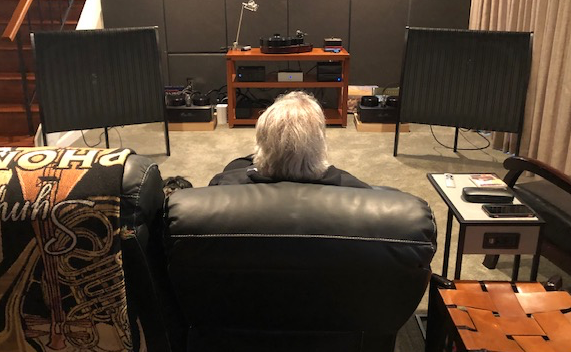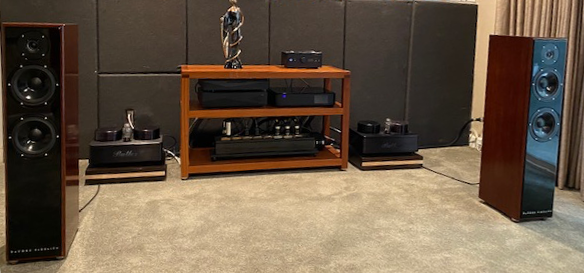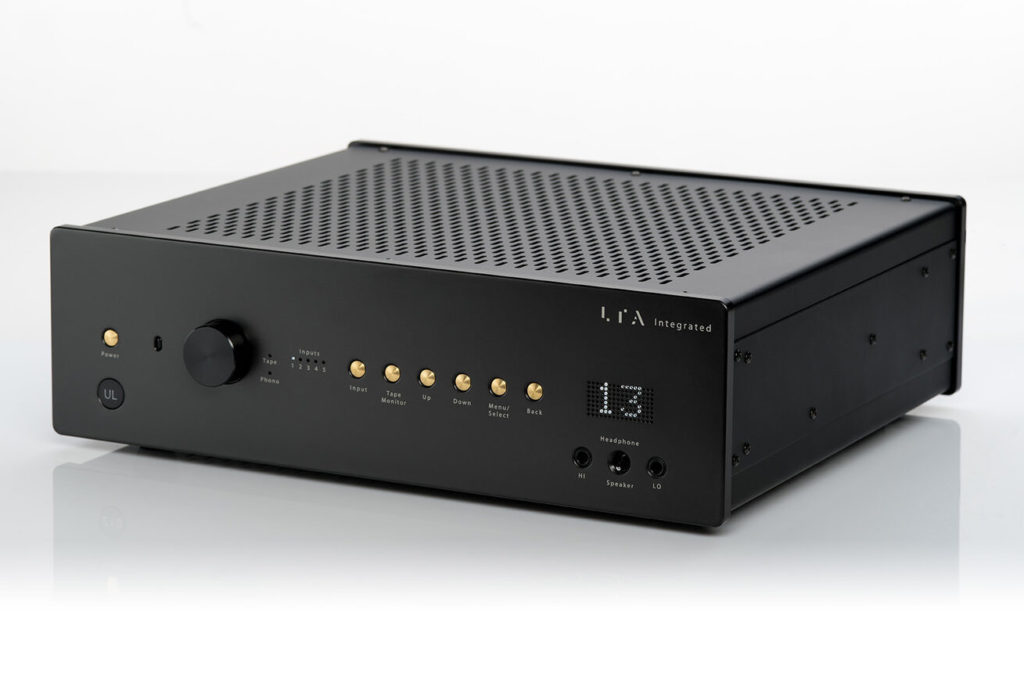A little over two years ago I reviewed the Linear Tube Audio Ultralinear Power Amplifier. In that review, I said it was the best sounding Class AB amplifier I had ever heard. Readers have since asked me to review the LTA Ultralinear Integrated Amplifier. With all that has been going on in the world for the last year, it took a little time to make this happen, but here’s my review.
Ultralinear Integrated Description
The LTA Ultralinear Integrated Amplifier is a combination of their ZOTL Ultralinear Amplifier, a Berning-designed preamplifier, and LTA’s digital control system. Fern & Roby designed the case, and the front panel looks very much like the LTA Reference Preamp.
The Ultralinear Integrated generates 20 watts per channel. It has two adjustable gain settings: 0db (default) and -10db. This adjusts the volume control to allow for finer low-level attenuation when using sensitive speakers or headphones.
While the Ultralinear was specifically designed with high-efficiency speakers in mind, it also plays well with others like the B&W or Rogers. It has all of the benefits of ZOTL technology such as three times the tube life, one-third of the heat, a super-wide frequency response of 8hz-60Khz, and an under 2-ohm output impedance. The amp also has a sophisticated speaker protection system to prevent damage to the amp and to your speakers, if there is ever a tube issue.
The Review System
In my reference system, the Ultralinear Integrated replaced my LTA Z3 preamp and the Butler Audio MONAD 100 monoblocks. It also eliminated the need for the 2-meter FrontRow interconnect and a 6-foot FrontRow power cable. That means that the $7,650 Ultralinear Integrated eliminated the need for over $35,000 of equipment. I used the amp with both my DeVore gibbon Super Nines and my Electrostatic Solutions QUAD ESL 57s.
One Question I Can’t Answer
If you want to know how the Ultralinear Integrated sounds compared to the Ultralinear ZOTL Power Amplifier or with the MZ3 Preamplifier, I can’t tell you. My system has just changed too much in the last two years. It’s hard to believe, but it’s been over two years since I’ve had the power amp in for review.
Listening with the QUAD ESLs

The Ultralinear Integrated has the kind of power you looked for from an amp if you owned the original QUAD ESLs. So, I listened to the Ultralinear Integrated first with the QUADs. This pairing made for simply beautiful music. Strings sounded so natural with a great sense of breath and space, not only around the instruments but also within the instruments.
When listening to strings, I was able to experience the excitement of a performance. I could hear when the bow first touched the strings and the beauty of the decay. The sound could be very sweet or very expressive, but it was never bright or strident. I could easily hear the different layers and textures of the tones of the strings as a bow passed over each of them. Massed strings were full-bodied and extended while never being abrasive.
Both male and female vocals sounded very natural. They had body and soul. The vocalist seemed to occupy a very realistic space. This resulted in voices that sounded more like real people singing and less like well-recorded voices.
When it comes to the bottom end, the Ultralinear Integrated drives the QUADs as deep as any amp I have heard. It doesn’t have the power of the Butler Audio MONAD 100 monoblocks, of course, but the Monad 100s do cost $19,000. Let me conclude this paragraph by saying the Ultralinear Integrated is the best integrated amp I have heard with my QUAD ESLs for under $10,000. By the way, that includes the Pass Labs XA30.8 and the First Watt SIT-3, two amps that I dearly love.
Listening with the DeVore gibbon Super Nines

I spent most of my time listening to the Ultralinear Integrated on my DeVore gibbon Super Nines. The Supper Nines are more efficient, and they are a much easier load for amps to drive. In fact, they are exactly the kind of speakers this amp was made to drive and it showed. The sound was simply stunning with this combo.
The Ultralinear Integrated’s sound starts with its ability to be both incredibly rich and nimble at the same time. The music flowed effortlessly into my room. The bass delivers real rhythm to the listener. It was very easy for me to feel like I was listening to live music.
Tonal accuracy is the most important thing to me. Just as I discovered when I reviewed the Ultralinear Power Amplifier, the Integrated has amazing tonal accuracy. Instruments and voices simply came to life in the room when I was listening.
This is an amplifier that pulls off a small miracle. It has such a big tone and at the same time, it is realistic. Yet the detail, speed, and micro-dynamics are not overdone. With the Integrated, my system seemed to introduce fewer distractions than I hear from most recorded music. This made it so much easier to be drawn into the music instead of listening to how my system sounds.
Recorded Performances
The power, scale, and drive in the performances was spot on with the Ultralinear Integrated driving the Super Nines. The sound could be huge, or it could be small and eloquent depending on the performance I was listening to.
This is another of those rare pieces of gear that can make listening to recorded music a truly emotional experience. This is what it is all about for me.
As important as everything I have talked about so far is, to me the most important thing for my system to get right is the sound of the human voice. With the Ultralinear Integrated singers had body and soul. Their voices sounded more like real people singing and less like well-recorded voices. The sound of the singers had real immediacy that gave the sound the aliveness that I have come to expect from my speakers when they are driven by a world-class amplifier.
Ultralinear Conclusion
This integrated amplifier is quite a bargain. To buy the Ultralinear power amp and their reference preamp would cost you $11,300. You would need another pair of interconnects and another power cord, which for me would be another $10,000. With its price of $7,650, the LTA Integrated amplifier is not only one of the best amplifiers in audio, but it is also one of the best bargains.
Price: $7,650



Great review! Would really like you to get a hold of the Z 40 integrated, and compare them.
Very different sounding presentations. I had the Z10, the Ultralinear, and the Z40 integrated amps all in my house with my Volti Rivals. While the Ultralinear was the most detailed, the Z40 and Z10 were both more engaging with my speakers. I bought the Z40.
Hello and thanks for the review. The Super Nines are fabulous speakers and getting the best from them can be like walking through a sonic Maxfield Parrish-like landscape. Well, to me anyway. I wonder how you’d compare this with the Pure Audio One integrated you reviewed a year or so ago?
On the practical side, the class A heat is concerning, but it sat in relatively tight quarters on the middle shelf of your rack. The LTA runs cooler? Tubes being tubes, I tend to love their sound, but Morrison is no slouch of a designer and I’ve enjoyed Plinius amps in the past – but frequently ran them in A/B because the heat was….well…HOT.
Thanks again, Art